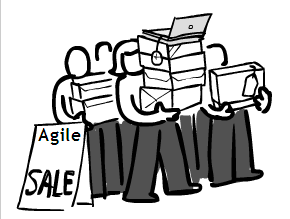 The post today was brought to you by... my hellish commute and those in the Washington DC metropolitan area who help create it. Thanks!
Today, I'm going describe Agile concepts by using my commute as the analogy.
The post today was brought to you by... my hellish commute and those in the Washington DC metropolitan area who help create it. Thanks!
Today, I'm going describe Agile concepts by using my commute as the analogy.
Goal
During any given day, spend as much time working or at home and as little time commuting as possible.
I'll write a User Story because I'm weird like that
As a project management advisor to a government PMO, I want to travel 55 miles in the shortest period of time so I can spend more of my life delivering value than wasting time sitting in traffic.
Predictive Approach
How long will it take to drive 55 miles to the office in the morning and 55 miles to my home in the evening? We've all had to estimate our commute time. Sucks, doesn't it!? We're all terrible at estimating. Why? Things change...constantly! You can spend as much time and energy as you want, trying to think of all of the possible scenarios. You can break your commute into "chunks" and estimate those. That could give you a better estimate, taking into account variances in each leg of the commute. But, until you get on the road and actually start your commute, you just don't know. We've got weather we need to deal with. We've got that knucklehead in the far left lane, driving 10MPH under the posted speed limit (with his blinker on). We have to deal with the occasional traffic accident. Work on a project is no different. You can try to estimate your time, up front, but when something happens (notice I wrote WHEN not IF) your original estimate is going to be wrong. What are you going to do? Are you going to try to make up the lost time later in your commute? Is something else going to be sacrificed like hours of work or hours at home?
Do I personally think there is a more accurate way to estimate a commute, as the commute happens? Yes.
Adaptive Approach
This was my Adaptive commute this morning. My wife told me that the traffic report on the radio stated there was an accident 40 miles into my commute. Good to know, I thought. Information is good. Communications is good. So, did I change my estimate at that time. Nope! Why, you ask? I was armed with my handy Droid X. My Droid X has GPS and Google Maps with a traffic overlay. Now, I still broke my commute down into chunks. I still had the basis of estimate there. But, the magic happened after the commute began. I did see the traffic slow down (on the map) that my wife referred to. But, the radio was still reporting that the lanes were blocked. The map indicated that traffic was getting by slowly. Good to know I thought. Information is good. Communications is good. But now, I saw (on the map) that traffic was stopped much earlier and they were not saying anything on the radio traffic report. By the way, the radio station only reports the traffic every 10 minutes. By getting realtime feedback from the Droid, I was able to know when I was going to have take a different route, to bypass the delay. I took the next exit and my commute route and the map refreshed. I could see, by the map, where I could get back onto my original route. I actually arrived to the office, 20 minutes from my optimum commute time. If I had not had the Droid and the constant feedback about the traffic conditions, it would have added a hour.
I still lost 20 minutes. But that was unavoidable. But I think I minimized my delays by getting real-time feedback. I had opportunities to adjust my course based on information. I was able to adjust my commute estimate every minute, not every 10 or 20 minutes. If someone from the PMO had called me to ask when I was going to get to the office, at any time along my commute, I could have given them a pretty good estimate. But that telephone call isn't necessary. Here comes the kicker. I share my location with Google Latitude. They can see where I am at any time.
Here are some things to think about for your next commute
- Know where you are and where you want to go
- Break your commute into chucks
- Get traffic conditions as often as possible
- Be prepared to change direction
- Be prepared to reestimate your time of arrival, the closer you get to your destination
- Give people a way to know your location so they don't have to ask you every 5 minutes
- Feedback is good
- Information is good
- Communications is good
Like the image? Find them at Pictofigo
 Tony Askey of Post-it Projects asked "[Are] Santa's elves using Kanban in the toy shop!!??
I can see it happening. But doesn't it sound a little disturbing hearing about Santa controlling his WIP? What are the elf labor laws like at the North Pole?
Tony Askey of Post-it Projects asked "[Are] Santa's elves using Kanban in the toy shop!!??
I can see it happening. But doesn't it sound a little disturbing hearing about Santa controlling his WIP? What are the elf labor laws like at the North Pole?

 I have 3x5's in my pockets, in my desk, on my desk...
I have 3x5's in my pockets, in my desk, on my desk... The white board at my desk is used as my personal kanban.
The white board at my desk is used as my personal kanban. I opted for the piggy timer because I have skin in the game
I opted for the piggy timer because I have skin in the game I love my post-it notes!
I love my post-it notes! You can never have enough coffee or Mountain Dew around the office
You can never have enough coffee or Mountain Dew around the office If you work in an open workspace, you need this
If you work in an open workspace, you need this







 Our second to last communications choice is telephone. Yes, telephone. It's a little better than email. At least you can sense emotion if you're listening closely. When communicating, use the senses you have available to get indirect feedback. Try smiling when you talk on the telephone. I bet the other person will know you are. I know telephone calls can really dirupt you flow of work but it's better than someone showing up at your desk unannounced. Timing of communications is almost as import as the method used. Try to plan your telephone calls. Voicemail is nothing more than audio email, as far as I'm concerned. Make sure you leave your name and telephone at the beginning of the voicemail (and end). Explain why you are calling. Don't just say you'll just call back. Voicemails are fragmented and can easily be taken out of context, if the relevant information is not included.
Our second to last communications choice is telephone. Yes, telephone. It's a little better than email. At least you can sense emotion if you're listening closely. When communicating, use the senses you have available to get indirect feedback. Try smiling when you talk on the telephone. I bet the other person will know you are. I know telephone calls can really dirupt you flow of work but it's better than someone showing up at your desk unannounced. Timing of communications is almost as import as the method used. Try to plan your telephone calls. Voicemail is nothing more than audio email, as far as I'm concerned. Make sure you leave your name and telephone at the beginning of the voicemail (and end). Explain why you are calling. Don't just say you'll just call back. Voicemails are fragmented and can easily be taken out of context, if the relevant information is not included.

